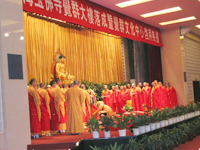
The most popular Buddhist temple in Shanghai city is back in use after its largest expansion ever. The expansion cost 130 million yuan (US$15.7 million).
The modern complex built in the Qing Dynasty (1644-1911) style includes multifunctional lecture halls, an exhibition hall, classrooms, guest rooms, offices, a dining hall and underground parking. It reopened one week ago.
A Buddha statue, worth US$17 million and carved from a piece of rosewood more than 10,000 years old, was donated to the Jade Buddha Temple the day it reopened.
"All the money is from the Jade Buddha Temple itself -- from what we earned from tickets and from donations," said Jue Xing, the current temple abbot.
The expansion has enlarged the 120-year-old temple by about 4,000 square meters to 12,700 square meters. It includes two floors to house the city's only Buddhism school.
Famous for the two jade Budd has brought back from Myanmar during the Qing Dynasty, the Jade Buddha Temple accounts for more than 90 per cent of all the 600,000 visits to Shanghai's more than 60 temples every year.
The temple sees more than 4,000 visitors each day, and in special occasions, the amount can reach 10,000, said Jue Xing.
"Most of these visits are paid by tourists from abroad, and the temple has become one of the most interesting places for foreign tourists," said an official surnamed Wang from the Shanghai Municipal Religion Bureau.
"The large amount of visits and small space had troubled us for long.
"Because of the limited space, the Shanghai Buddhism School in our temple could recruit students only once every three years and only 30 each time.
"To study Buddhism in a better environment has been the dream of our monks and Buddhists for many years."
In September 2000, a hospital neighboring the temple moved away and left 4,000 square meters of space behind.
"The municipal and district governments, which had been concerned about our space problems, came to ask us whether we would like the space," said Jue Xing.
The temple purchased the land at a price of 45 million yuan (US$5.4 million) and started constructing in March of 2003.
"We have been given lots of help from the government on purchasing the land, getting approval from related departments and settling problems during constructing," said Jue Xing.
"The endeavor demonstrates the country's insistence on freedom of religious belief," said Sheng Hui, deputy director of the Chinese Buddhists Association.
It is said that the expansion now allows the Buddhism school to recruit more students, from the current 30 to 60, and then to 200 finally.
In addition, the school plans to appeal to the State Bureau of Religious Affairs to promote the current secondary school to a college.
"We are going to send 15 of our young monks to Shanghai University of International Studies to take a four-year course on foreign languages to meet the upcoming 2008 Olympic Games in Beijing and the World Expo in 2010 in Shanghai," said Jue Xing.
(China Daily November 24, 2004)
|

